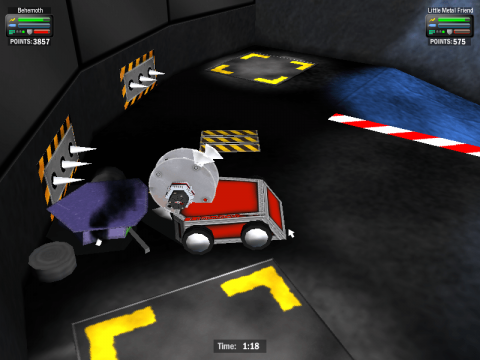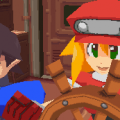- Robot Arena
- Robot Arena 2: Design & Destroy
- Robot Arena III
Robot Arena 2: Design & Destroy is a title so pivotal in the robot combat community that near 20 years after its release there is still a hearty player base and lively modding scene surrounding it. Robot Arena 2’s longevity can be attributed to striking the perfect balance between arcade and simulation.
Whereas the original Robot Arena was a simple affair that locked the player into one of a half-dozen premade chassis shapes players of Robot Arena 2 will see these restrictions completely obliterated right from the start. Instead of picking a chassis the game provides the player with a digital sheet of graphing paper where points can be placed to make a chassis as big or small as desired and in whatever shape the player can think up. There are some limitations with the 3D engine that prohibit obvious things such as intersecting points but for the most part if you can dream it you can literally plot it out and build it. Tools are even provided to help easily plot out circular shapes if it’s a spinner-style robot you’re itching to create.
After designing a blueprint the next step is to choose an armor and this is where another quality of life improvement shows up: the removal of the money system. Robot Arena was unfriendly to design freedom with its constraining in-game cash system that limited what beginner players could build. Now there’s no limit; the metaphorical leash has been taken off and from square one players can build their dream machine. Because there’s no cash instead players will notice weight plays a more critical role in what they build because Robot Arena 2 introduces a rudimentary weight class system; robots can either be lightweights, middleweights, or heavyweights. These classes are loosely based on the popular BattleBots television show with the notable omission of the “super heavyweight” class of robots. Given the generous weight allowance between becoming a heavyweight and hitting the in-game weight limit there’s reason to believe a super heavyweight class was considered but left out for unknown reasons.
Unlike Robot Arena, which allowed the player to drop in some batteries and attach things only to the outside of their robots, Robot Arena 2 provides full freedom to place parts anywhere on or within the 3D model of the chassis generated from the blueprint in the first step. Players can choose from a variety of motors of differing sizes, speeds, and power alongside new mechanical parts such as pneumatic pistons, hydraulic actuators, and “burst motors” which is the game’s way of simplifying complex mechanical designs behind hammers and flippers. Other menus within the Bot Lab contain weapons like saw blades and axes as well as extension rods to create things like sledgehammers and even defensive attachments such as armor plating and plows. Newcomers will genuinely feel like a kid in a candy store just simply browsing all there is to build with. It falls just short of being overwhelming because the designers didn’t overdo it with the parts system.
Construction of a robot is just advanced enough to remain easy for a layperson to understand while remaining powerful enough to allow expert players to fine tune their designs into something truly devastating. But the real test of how destructive a robot can be comes with the main event of combat. From within the Team HQ section of the game players can choose from various events that all take place in different arenas and with different battle styles. Some events will have you fighting on a rooftop in a one-on-one battle to the death while others will toss you into an empty parking lot with three other opponents in a hectic four-way melee where only one robot can come out victorious. If that’s not enough players can also set up their own events in Exhibition mode and choose from any arena and any opponents, even being able to mix weight classes so frustrations can be taken out by smashing smaller robots with the world’s biggest hammer.
Robot Arena 2 served as a sort of “swan song” for American robot combat; being released in 2003 meant that it preceded the cancellation of BattleBots by only a few months. The demise of the BattleBots show arguably invigorated the Robot Arena 2 community to make the best out of a bad situation and keep the spirit of the show alive by way of creating it inside of the game. Although Robot Arena 2’s multiplayer was spotty at best and rife with hiccups and “explosions” of the Havok physics engine the game lived on. Players connected with each other on various forums and message boards to arrange tournaments and provide updates on new mods that were being worked on for the game. Among the most notable mods are “DSL” and “Ironforge” which are two complete overhauls of the Robot Arena 2 building system to allow for a level of design granularity far beyond what Gabriel Interactive could even dream of back in 2003. It is important to note that these high level design mods work within the standard Robot Arena 2 game meaning that even in 2022 this trooper of a classic PC game is able to handle whatever’s thrown at it.
Robot Arena was an imperfect game that sticks out today as a fun novelty to go back and rediscover to see where robot combat video games got their start but Robot Arena 2 is the game that dared to dream where these games could go. ■


